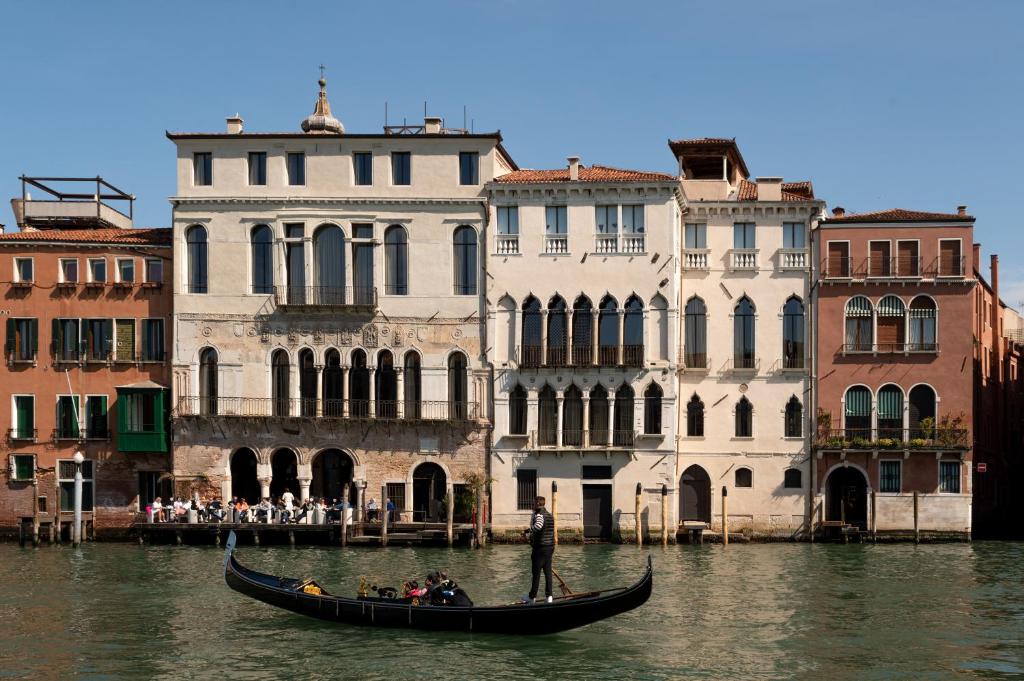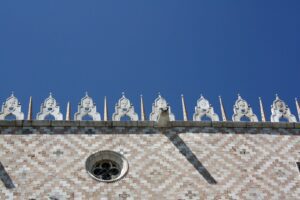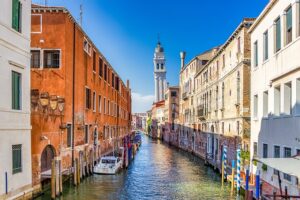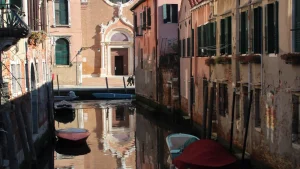🌊 How Venice Was Built on Water: The True Story Behind the Floating City
Venice isn’t supposed to exist — and yet, it does. Perfectly balanced between water, sky, and human determination.
🛶 Introduction: A Floating Marvel
Venice is a city that seems to defy logic. How can a city of marble palaces, cathedrals, and busy piazzas float on a lagoon? Who looked at a stretch of muddy islands and thought, “Yes — this is where we’ll build one of the greatest cities in Europe”?
And yet, Venice not only survived — it thrived. For more than a thousand years, this improbable city ruled the seas, amassed immense wealth, and became a beacon of art and culture. But to understand Venice’s beauty, we must first unravel its origin story — the unlikely tale of how a city rose from the mud and built an empire on water.
Let’s dive (carefully!) into the real history of how Venice came to be — and why it still floats today.
🏝️ 1. The Origins: Why Was Venice Built in a Lagoon?
Venice was born out of desperation, not design. Around the 5th century AD, as the Western Roman Empire collapsed under waves of barbarian invasions, refugees fled from cities like Aquileia, Padua, and Altinum. Seeking safety, they escaped into the Venetian Lagoon — a swampy, mosquito-filled maze of sandbanks and tidal channels that no army dared to enter.
Key point: The lagoon was the perfect natural fortress — impossible to invade with horses or siege engines. What began as a temporary refuge slowly transformed into a permanent civilization.
🛖 2. Early Settlements: Life on the Mud
The first Venetians were fishermen, salt gatherers, and boat builders who adapted to their watery world. They lived in wooden huts raised on stilts above the marshes, building communities on islands like:
- Torcello — one of the earliest centers of life in the lagoon
- Murano — later famous for glassmaking
- Burano — the colorful island of lace and fishermen
- Rivo Alto — the “High Bank,” later known as Rialto, the heart of modern Venice
They survived on fishing, salt production, and lagoon trade with the Byzantine Empire across the Adriatic. Over time, their wooden villages evolved into a thriving network of islands — a community learning to live with water, not against it.
⚒️ 3. How Venice Was Built: An Engineering Miracle
Venice wasn’t just built — it was engineered. Every palace, church, and bridge stands on foundations that modern engineers still marvel at today.
🚧 Building on Mud: The Venetian Method
- Wooden Pilings: Millions of timber poles (often oak or larch) were driven deep into the mud until they reached compact clay layers.
- Stone Platforms: Wooden beams and stone slabs distributed the weight evenly.
- Lightweight Materials: Builders used brick and Istrian limestone to keep structures strong but flexible.
The secret? The wood doesn’t rot. Submerged in oxygen-poor, mineral-rich water, the timber petrifies over centuries, turning hard as stone.
Even today, beneath the Grand Canal, forests of ancient logs hold up entire neighborhoods.
📜 4. The Rise of the Venetian Republic
By the 9th century, the scattered lagoon islands united under a single leader — the Doge of Venice. This marked the birth of the Most Serene Republic of Venice, a maritime superpower that would last for over 1,000 years.
Thanks to its strategic position between East and West, Venice became a global hub for trade and diplomacy. Its shipyards — the Venetian Arsenal — built fleets faster than any rival, while merchants brought silk, spices, and glass from across the world. The city that began as a muddy refuge became the jewel of the Adriatic.
🌊 5. Why Stay in the Lagoon? The Strategy of Survival
Venice’s location wasn’t an accident — it was genius. The lagoon offered:
- Safety from invasions: Armies couldn’t reach it.
- Control of trade routes: Perfectly placed between East and West.
- Natural resources: Salt, fish, and waterways for commerce.
- Political independence: Protected from both Byzantine and Holy Roman influence.
Water wasn’t Venice’s weakness — it was her weapon, shield, and identity.
🏛️ 6. From Refuge to Renaissance: Venice Grows in Splendor
As wealth poured in, Venice built upward, not outward. Limited space meant vertical cities — narrow alleys, high palaces, and hundreds of bridges connecting 118 islands.
Key landmarks soon defined the skyline:
- St. Mark’s Basilica: Built in the 9th century to house the relics of Saint Mark.
- The Doge’s Palace: The seat of power — where politics met art.
- The Grand Canal: Venice’s watery main street, lined with merchant palaces and stories of glory.
Each brick, arch, and mosaic reflected the republic’s belief that beauty was power.
🧭 7. Who “Built” Venice?
Unlike Rome or Paris, Venice had no single founder. It grew organically — a collective creation of generations. Still, several figures left their mark:
- Paolo Lucio Anafesto: Considered Venice’s first Doge, uniting early settlements.
- Enrico Dandolo: The blind Doge who led the Fourth Crusade, securing Venice’s wealth.
- Anonymous engineers: The real heroes who mastered how to make stone float.
Venice wasn’t built in a day — it was built over centuries, each generation perfecting what the last began.
🌉 8. How Venice Keeps from Sinking
For 1,500 years, Venice has stood — and floated — thanks to maintenance, ingenuity, and a touch of luck. Wooden foundations remain preserved underwater, while canals are constantly dredged and reinforced. But modern threats have changed the equation:
- Rising sea levels and climate change
- Motorboat waves eroding foundations
- Mass tourism pressure on infrastructure
Still, Venetians persist — adapting just as their ancestors did. Projects like MOSE, a vast underwater barrier, help protect the lagoon during extreme tides.
🌦️ 9. Why Does Venice Flood? Understanding Acqua Alta
Acqua alta — or “high water” — happens when strong winds and tides push seawater into the lagoon. It’s part natural rhythm, part climate crisis. Streets flood, wooden walkways appear, and Venetians pull on their boots and keep moving.
Learn more in our guide: What Is Acqua Alta and When Does It Happen?
🛳️ 10. Venice Today: A Living City on Water
Modern Venice still functions much like it did centuries ago — just with smartphones and espresso machines. There are no cars or roads, and everything moves by boat or cart: mail, groceries, even garbage. Over 25 million visitors arrive each year to experience its surreal beauty — yet beneath the crowds, Venice remains a functioning community of 50,000 residents keeping traditions alive.
🧭 See Venice Through Local Eyes
Want to truly understand how this floating city works? Join us at Tour Leader Venice for an insider look at the past and present of La Serenissima.
- Venice Origins Tour – How and Why the City Was Built on Water
- Venice by Boat: Life on the Canals
- Doge’s Palace & St. Mark’s Private Tour
Every ripple tells a story — let us guide you through it.
📝 In Summary
| Question | Answer |
|---|---|
| Who built Venice? | Roman refugees fleeing invasions in the 5th century AD. |
| Why on water? | Safety — the lagoon was a natural fortress. |
| How was it built? | Millions of wooden poles driven into mud, topped with stone platforms. |
| What made it thrive? | Trade, strategy, independence, and sheer Venetian ingenuity. |
| Why is it still standing? | Ingenious engineering and constant care by generations of Venetians. |
Venice isn’t built on land — it’s built on determination, vision, and water. Once you see it through the eyes of a local, you’ll understand why this city continues to capture the world’s imagination.
FAQs
Can you still see how Venice was built today?
Yes! Many of Venice’s ancient engineering secrets are hidden in plain sight — from the wooden foundations beneath the Rialto Bridge to the elegant arches of the Doge’s Palace. To see these marvels up close, join our Venice Origins Tour — How and Why the City Was Built on Water or our Doge’s Palace & St. Mark’s Basilica Private Tour. Your licensed guide will show you where history meets hydrology — and why the city still stands after 1,500 years.
Why doesn’t Venice sink?
Venice rests on millions of wooden piles driven deep into clay and sand. Submerged in oxygen-poor lagoon water, these timbers petrify rather than rot — becoming harder than stone. Regular maintenance and modern projects like the MOSE barrier keep the lagoon balanced. For a fascinating look at how the city survives tides and time, explore our Venice Tour of the Lagoon — Discover the Hidden Gems or read our detailed guide What Is Acqua Alta and When Does It Happen?
What’s the best way to learn about Venice’s origins?
See it the way locals do — by walking and boating through history. Combine our Venice Walking Tour — Discover the Real City with a Private 1-Hour Boat Tour (Grand Canal + Hidden Canals) for the full story from the mudflats of Torcello to the marble façades of St. Mark’s. You’ll trace the city’s transformation from a refuge in the marshes to the most sophisticated republic on water.







